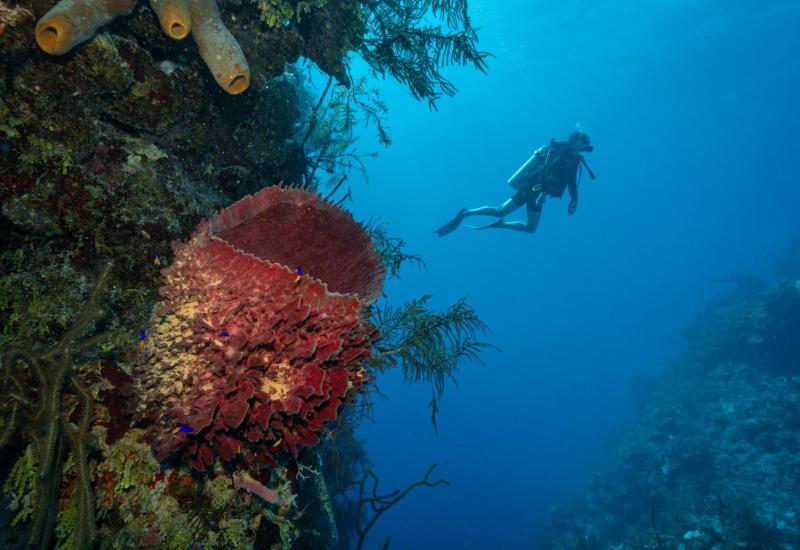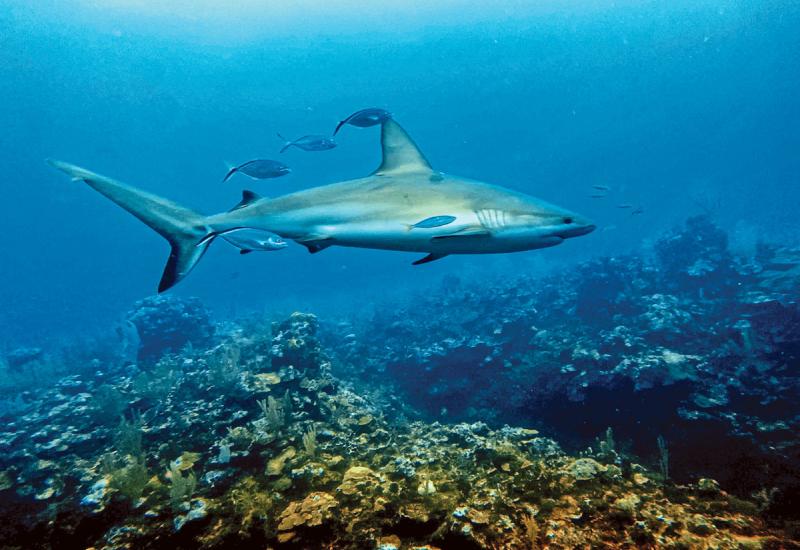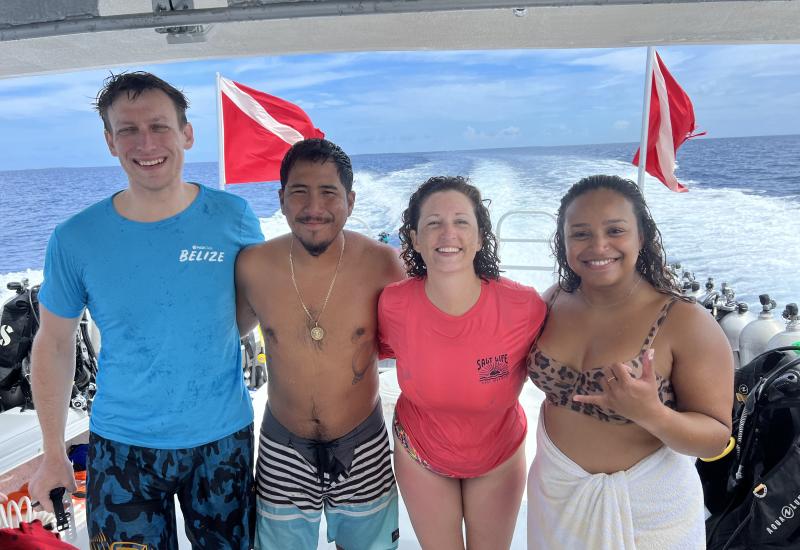Photo Talk - Blunders
Close Encounters of the Turtle Kind - There I was, gliding effortlessly in a mild current through clear water, over the reef ledge with a beautiful, deep-blue, open-water background to my right. The other divers - eight in all - were far enough away so I could get reef pictures without a diver in the frame, just as we'd all planned. Suddenly, I spotted a huge hawksbill sitting on a coral head, its head up high, its flippers outstretched. I immediately came to a full stop in the water. Looking around for the best possible shot, I looked up and saw a beautiful underwater sunburst behind the turtle. I knew from experience that if I swam in slowly, I could get off just one shot - possibly a cover, I was thinking - before the animal lifted off into the blue. I set camera controls and made my move, ever so slowly. Then the attack occurred. A diver swam as fast as she could into the frame to pet the turtle, perhaps not knowing the extremely wide field of view of my lens. But that's no excuse because the diver should have followed the underwater photographer's common-sense rule of backing off if you see someone shooting. Snap! Subject - and cover shot - were gone. Dive Bombing the Sea Horse - Descend slowly. Watch your buoyancy. Gather around me, and I'll show you one of our most beautiful animals. These were the fateful words of our dive master moments before we entered the water. I was with a group of photographers, and we all wanted the same thing: a great, full-frame shot of a sea horse. I was in the water first, following the dive master. We descended to a sea fan on the sandy bottom. He pointed and I saw the beautiful creature. Several other divers descended ever so slowly, and we circled around the animal. Because I was the first in the water, I got to shoot first. I raised my camera and framed the subject. Just as I was about to shoot, an over-weighted diver, with apparently nary a clue about buoyancy, came smashing into the sea fan. My subject (hopefully still alive) disappeared in the ensuing cloud of dust. We left the scene, shaking our heads in total amazement. Surviving the Sandstorm - The two zebra morays were poking their heads out of a mini-cave in the reef. This time, I was not the first diver in the water, but the second. I patiently waited my turn to photograph these fierce-looking animals, their heads side by side. The shooter took his time, which was perfectly OK with me. After taking about a dozen exposures, the shooter looked at me and gave the OK sign. I signaled back. Then he put his hand in the sand, pushed off and gave a quick kick of his fins. These actions created an underwater sandstorm-making it impossible for me to take a picture and nearly choking the morays to death. My next hand signal wasn't the OK sign. Cuttlefish Chaos - Cuttlefish are not hard to photograph, but they sometimes are hard to find because of their excellent camouflage techniques. So there we were: Five divers all looking for the cuttlefish the dive master said we'd definitely spot. Sure enough, there they were: a mating pair. The female was in the process of depositing eggs in a crevice in the reef - a fantastic photo opportunity.Within about 10 seconds, every diver charged the peaceful animals scaring the hell out of them and causing them to lose their color as well as stop what they were doing. What's more, the divers clustered around the animals and kicked wildly to maintain position, the result of which was to fill the water column with silt, sediment and sand. The end of this little tale? No one got a single decent shot. Attacking the Reef - This attack was probably deadly. There I was in a very strong current, photographing a pair of spine-cheek clownfish hovering over a sea anemone. To keep in place, I held onto the underside of a fortuitously dead piece of coral rock. I was almost vertical in the water, keeping off the fragile reef. Observing the animals, I marveled at how effortlessly they stayed in position. After I took my shots, I signaled another diver to come over and get a shot. After all, I do like to share my finds with my fellow underwater shooters. He swam over, beaming with excitement. I was happy for him ... for about three seconds. To get into position, he grabbed a live section of coral, knowing full well, I'm sure, that this action removes the coral's protective mucus covering. Suddenly, the chunk of coral snapped off: a death sentence for that particular colony. He grabbed another piece of live coral. Another snap. That was enough for me. I grabbed his arm and lifted him off the reef, shaking my head in disbelief. Tornado on the Camera Table - For most underwater photographers, myself included, live-aboard vessels are the way to go, for two reasons: One, you can usually make five dives a day; and two, you have all your camera equipment readily available on the ship's common table. On live-aboards, as on all ships, space is limited, so passengers need to be courteous about storing their gear - and gear includes cameras. Well, on one of my trips, I encountered a diver who obviously never heeded his mother's advice about putting his toys away. Although we had eight photographers aboard, he thought the two-tiered camera table was all his. Sure, his cameras - like ours - had to be on the table and readily available just in case that whale shark swam past. But this guy had screwdrivers, pliers, synch cords, flash diffusers, extra strobe arms and bracket, batteries and film canisters strewn all around his rig, making it hard for the other divers to find their own space on the table. The other divers had obviously listened to mom - they all stored their accessories in dry boxes or fishing-type gear boxes. Guess who was the most unpopular guy on the boat? Earth to Photographer: Some of these problems can be solved by simple courtesy; some require practice or refinement of basic dive skills; and some require common sense. Some require adherence to the Golden Rule: Do unto others ... And some require adherence to the Golden Rule of conservation-minded photographers: Take only pictures and leave only bubbles. The picture is important to a photographer. But more important is obtaining the picture and leaving the subject just as you found it for the next diver. And it doesn't hurt to be considerate of others, either! For more information about underwater strobes, lenses, camera housings, amphibious cameras and other photo products, click onto the Sea & Sea home page below.__










